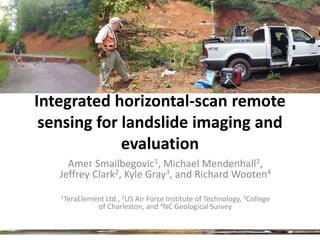
Integrated horizontal-scan remote sensing for landslide imaging and evaluation
- 1. Integrated horizontal-scan remote sensing for landslide imaging and evaluation Amer Smailbegovic1, Michael Mendenhall2, Jeffrey Clark2, Kyle Gray3, and Richard Wooten4 1TeraElementLtd., 2US Air Force Institute of Technology, 3College of Charleston, and 4NC Geological Survey
- 2. The Landslide: Franklin, NC Located in the Appalachian Mountains of the Eastern United States Image/map courtesy of NC Geological Survey
- 3. Landslide: Geology requirements Unstable slope: 35 – 65 degrees Expansive Clays Deteriorating host Water Host rock: Amphibolites/schist withsignificant concentrations of pyrite aswell as deteriorating igneous rocks Alluvium, sands, clays all present as process of host rock decomposition continues
- 4. Landslide: How it works Deforestation: decreasing vegetative cover can increase risk by as much as 50%, change in water absorption-holding factor-climate. Soil mineralogy: water expansive clays, poorly draining soils, mixed soil types, lateritization and deterioration of the host rock by weathering/leaching Increased loading: Loading unstable, poorly rooted layers may result in collapse (e.g. water load, structure load) Slope angle: determination of risky slopes particular for an area
- 5. Landslide: Observables Fracture Sulfates SPECTRAL SIDE: LIDAR side: -Identify zones of weathered rock and -Identify zones of weakness (fractures, byproducts of acid-digestion: sulfates faults, sliding blocks) -Identify zones of clay minerals that -Identify zones of high / risky slope swell by as much as 200% when hydrated (e.g. montmorillonite)
- 6. The People (is it a landslide if no one is around to notice) Currently the area is contentious and attracting different attention for variety of purposes: study, safety, litigation, development, transportation and infrastructure. One must exercise caution in approach not to trigger existing and other non-geological landslides
- 7. The Plan AREA IMAGED Hyperspectral LIDAR
- 8. Equipment Velodyne High Def LIDAR (HDL-64E S2) 360 Deg Horizontal FOV HyperSpecTIR (HST) -3 26.8 Deg Vertical FOV Third model of SpecTIR’s airborne scanner, which 1.3M Points per second saw airborne action until 2006 when it was 2 Co-mounted Hi Res framing cameras relegated to ground use. 227 bands, 1mRad FOV, 450-2450 spectral range.
- 9. Technical Challenge • Low signal-to-noise ratio (hyperspectral) • Cause: scene geometry & horizontal config – Specular component is the largest contributor of RTR – Specular component hits the ground plane – Only weak diffuse component reaches the imager Result low SNR… RDiff RTR=RDiff+RSpec RSpec RDiff RSpec Hill Side Imager Ground Plane
- 10. Mitigating SNR Issues Transform-based denoising may occur prior to atmospheric compensation – work in progress • Processing Chain Image Acquisition I1 Reflectance I2 Super Resolution: ISR Atmospheric C ˆC I Signal ISR I1, I 2 , , I n SR ISR Compensation … In Denoising • Super Resolution: – 10’s of images with stationary imager – average yields good recovery of true radiance image • Atmospheric Compensation: Currently Flat Field • Denoising Efforts: Savitzy-Golay – Savitzy-Golay filtering used in this study – Ongoing: Discrete Wavelet Transform & Discrete Fourier Transform denoising method
- 11. Some Intermediate Results • Super Resolution • (μOrig- μSR) white panel – (σOrig-σSR) white panel – Orig overly bright w/large • Significant reduction in σ in VIS deviation from estimate of μ • Notable reduction in σ in SWIR 80 120 60 100 Aprrox crossover point 40 80 between VNIR & SWIR Detectors 20 60 0 40 -20 20 0 -40 600 800 1000 1200 1400 1600 1800 2000 2200 2400 Wavelength in nm -20 600 800 1000 1200 1400 1600 1800 2000 2200 2400 Wavelength in nm • Savitzy-Golay Smoothing 1 0.4 0.35 0.95 0.3 0.9 0.25 FFSG , FF 2 FFSG , FF 0.2 0.85 2 0.15 0.8 White Panel Mean: 0.1 White Panel Variance: 0.75 Savitzy-Golay (red) 0.05 Savitzy-Golay (red) 0.7 Non-Noised (black) 0 Non-Noised (black) 600 800 1000 1200 1400 1600 1800 2000 2200 2400 600 800 1000 1200 1400 1600 1800 2000 2200 2400
- 12. Hyperspectral Data Scene 3 Scene 1 Cal Panels for ELM The King of Pop has reemerged In-scene spectral diversity
- 13. Target Minerals Reflectance Spectra De-noised using Savitzky-Golay regression
- 14. On Scene Example of hyperspectral detection of minerals – classification results overlain on natural-color RGB composite: RED – water expanding mineral suite with evidence of sulfate minerals indicating rock-decomposition processes GREEN – water expanding clay minerals only
- 15. LIDAR Color-shaded, horizontal- looking LIDAR data showing some of the apparent structural elements of significance to landslide formation and/or propagation.
- 16. LIDAR Water-expanding mineral suite on LIDAR scan
- 17. LIDAR Isolated block Some of the possible targets for another landslide: note potentially compromised block in the center Structure Large area of compromised rock Zone of Weakness and clay minerals on the right is an evidence of an exposed face, but lack of structural elements does not Example of integrated LIDAR and HSI-produced maps make it as risky as the location on the left
- 18. Directions • Technical – Atmospheric Correction • Tradeoffs between MODTRAN, on-site irradiance spectra, ELM, and Flat Field for the horizontal scan configuration – Digital Signal Processing • Incorporate Sensor Noise Model • Detailed study on denoising affects (S-G, DWT, DFT) – Create a workable geotechnical model from new input data
- 19. Conclusions – It is possible to delineate zones of “problematic” mineralogy on a wider scale using horizontal- looking hyperspectral imagery – It is possible to delineate zones of structural weakness and/or landslide formation elements using horizontal-looking LIDAR data – Integrating LIDAR and hyperspectral data shows promising results as a tool in observing and tracking existing landslide areas – Fills important elements in geotechnical evaluation: mineralogy and structure